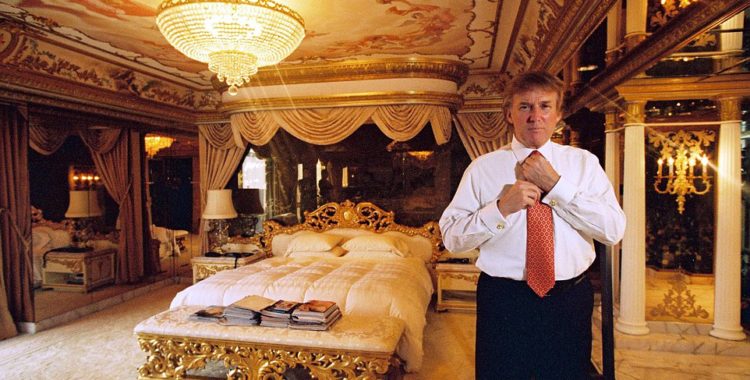
Making America Gilded Again: Aesthetics, Economics, and Trump’s Style
November 11, 2016
by Diana Greenwald | Filed in: Current Events
There have been many, many critiques leveled against President-elect Donald Trump over the course of his campaign and in the few days since his shocking victory. More than a handful of these have been aesthetic. Investigations of his hair, memes mocking it and his unnaturally tan face, and close examinations of his wife Melania’s sartorial choices and other family members’ personal style are just some of the many aesthetically-grounded criticisms of the future president of the United States. This post is the first of two that explores Trump’s aesthetic tastes and how and why they have both offended and inspired the American electorate.
With the exception of comments about Trump’s hair, no aesthetic critique has been more common than the panning of his taste for gilded interior design—including a rumor that he has a golden toilet in his Trump Tower apartment. The Trumps’ extravagant taste for golden Louis XIV style, which has been on display in several journalistic features, has been criticized not just because it shows that the homeowners are wealthy, but it because it is such a blatant display of wealth. A rich person choosing a golden Versailles-like decorating scheme is, in the minds of most critics, vulgar—a good overview of the criticism is here (in the context a lukewarm defense of Trump’s stylistic choices over the years). It is interesting to contrast critical reception of the Trump family’s taste with that of leaked photos of another billionaire-politician, former New York Mayor Michael Bloomberg. The critical commentary on the mayor’s over-the-top “baronial style” is interspersed with reminders of his more stark taste for his business’ headquarters and his extensive philanthropic giving.
Extravagant displays of wealth in billionaires’ homes are only acceptable if their other behaviors are generous and measured. If their behavior—like Donald Trump’s—is extravagant, then having overt displays of wealth in your home are totally offensive. There is a delicate balance that wealthy people must maintain between extravagance and modesty, between inciting envy among those who are less fortunate and not rubbing richness in the face of the 99%. Guidance for understanding this standard for the taste of wealthy people, and why people think that tastes for homes and clothing are important barometers of character, comes from sociology.
The most famous commentary on this topic comes from Pierre Bourdieu’s Distinction: A Social Critique of the Judgment of Taste (1979). Bourdieu argues how class distinctions are made not only through differences in economic capital but through differences in “cultural capital” as well. Bourdieu begins his argument with the assertion that “there is an economy of cultural goods [with] a specific logic.”[1] This logic is determined by the education and upbringing—the habitus—of the participants in the cultural economy. He writes: “In a sense, one can say that the capacity to see (voir) is a function of the knowledge (savoir)…A work of art has meaning and interest only for someone who possesses the cultural competence, that is the code into which it is encoded…A beholder who lacks the specific code feels lost in a chaos of sounds and rhythms, colors and lines, without rhyme or reason.”[2]
Because transacting in this cultural economy demands this encoding—namely a certain habitus—Bourdieu concludes that class may not only be expressed but also defined and transmitted to future generations through the consumption of cultural goods. Finally, he argues that formation of class distinction on the basis of cultural tastes is particularly effective. While upwardly mobile people may be able to accumulate financial capital in one lifetime, cultural understanding is the product of “total, early, imperceptible learning, performed within the family from the earliest days of life and extended by a scholastic learning which presupposes and completes it…. …(B)ourgeois families hand [this] down to their offspring as if it were an heirloom.”[3]
Donald Trump was born wealthy, but without this cultural inheritance. Much has been made of his upbringing in Queens, a traditionally working-class borough of New York City. Trump’s cultural capital does not match his financial capital—and this breaches the norms of the intersection between wealth and taste that Bourdieu describes. In essence, Donald Trump combines working class tastes with a billionaire’s budget. Perhaps this explains some of his ability to connect with an electorate whose homes and lived experiences are very far from a Fifth Avenue skyscraper.
[1] Pierre Bourdieu, Distinction: A Social Critique of the Judgement of Taste trans. Richard Nice (Oxford: Routledge, 1984), xxv
[2] Ibid.
[3] Bourdieu, Distinction, 59
<< Is It For Sale? Kanye West’s “Famous” and the Definition of Art
